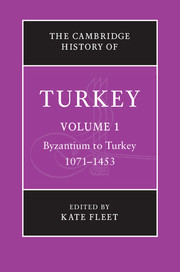Book contents
- Frontmatter
- 1 Introduction
- 2 The Byzantine Empire from the eleventh to the fifteenth century
- 3 Anatolia under the Mongols
- 4 Anatolia, 1300–1451
- 5 The incorporation of the Balkans into the Ottoman Empire, 1353–1453
- 6 Ottoman warfare, 1300–1453
- 7 The Turkish economy, 1071–1453
- 8 Art and architecture, 1300–1453
- 9 Social, cultural and intellectual life, 1071–1453
- Glossary
- Bibliography
- Index
- References
4 - Anatolia, 1300–1451
Published online by Cambridge University Press: 28 March 2010
- Frontmatter
- 1 Introduction
- 2 The Byzantine Empire from the eleventh to the fifteenth century
- 3 Anatolia under the Mongols
- 4 Anatolia, 1300–1451
- 5 The incorporation of the Balkans into the Ottoman Empire, 1353–1453
- 6 Ottoman warfare, 1300–1453
- 7 The Turkish economy, 1071–1453
- 8 Art and architecture, 1300–1453
- 9 Social, cultural and intellectual life, 1071–1453
- Glossary
- Bibliography
- Index
- References
Summary
This chapter narrates and discusses some major lines of development in Anatolia between the turn of the fourteenth century and the second accession to power of Mehmed II. The emphasis lies on the early Ottoman enterprise, thanks to the fact that it had become the major power in the peninsula by the end of the 150 years under discussion. The end point of our coverage is entirely reasonable, as there is general agreement that Mehmed the Conqueror's reign was a turning point in the creation of one imperial polity and the wreck of another, Byzantium.
It is far from clear, around the year 1300, that anyone should have expected such an outcome, for in 1300 the Mongols seemed to be suzerains of the area we term the Ottomans' homeland. In fact, the number of those in 1299 and 1300 who recognised the period as a caesura in Anatolia's history was small, perhaps a hundred people, almost all of them men. We do not yet know any of their names, but we do know that they were the moneyers active in the Muslim domains of the peninsula. From the 1280s until 1299, there were about ten mints striking silver dirhems for the Seljuks and Ilkhanids. For the years immediately after 1300, the number (now almost entirely for the Ikhanids) is also around ten. But in 699/1299–1300, the number of mints striking silver dirhems shoots up to forty-six. Such a phenomenon has not occurred before or since in the recorded history of Anatolia.
- Type
- Chapter
- Information
- The Cambridge History of Turkey , pp. 102 - 137Publisher: Cambridge University PressPrint publication year: 2009
References
- 6
- Cited by



